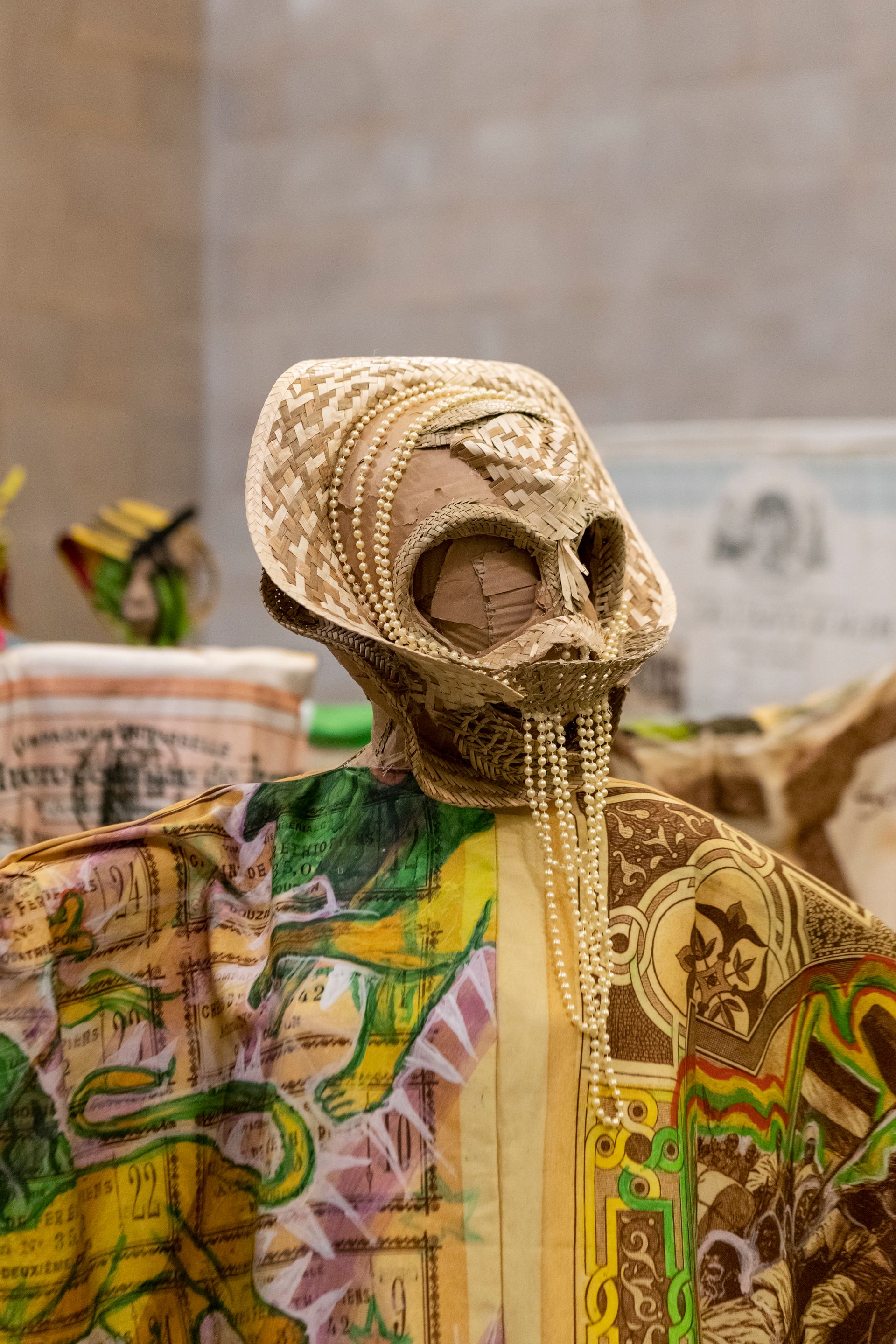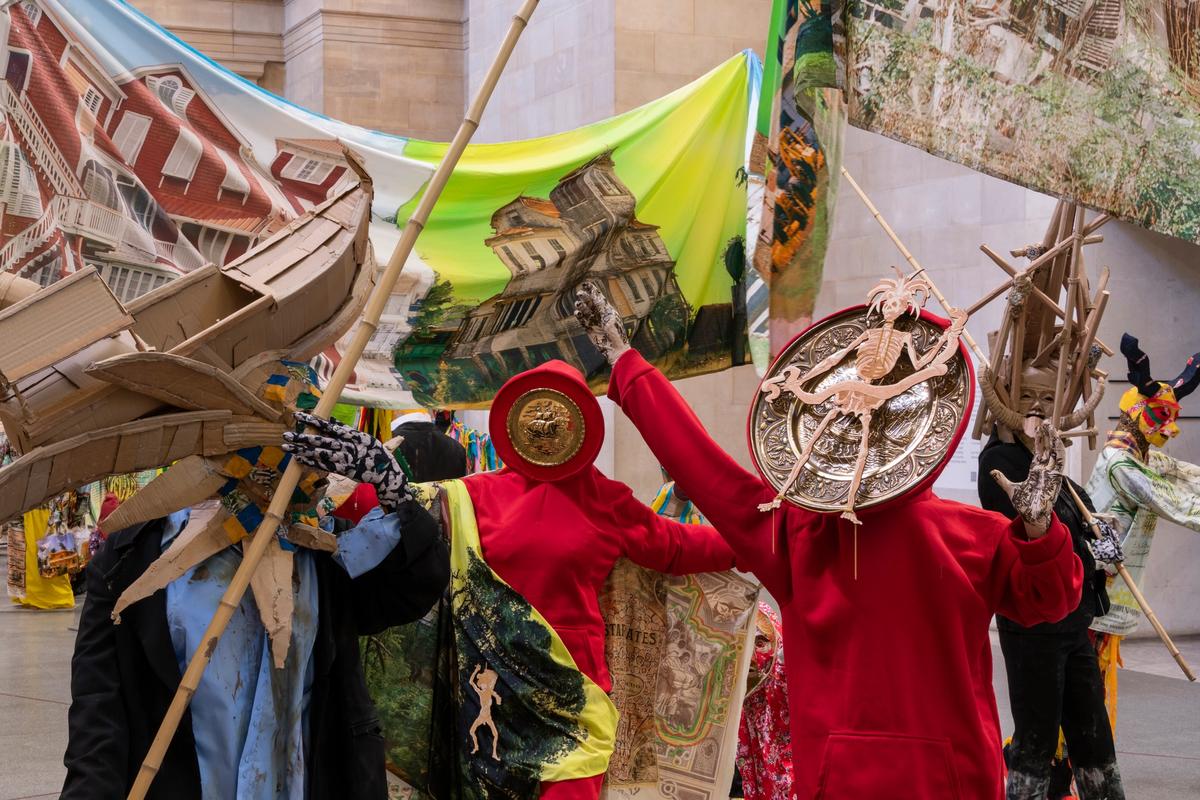Of course it is not a competition, but Tate Britain’s two most recent public commissions: Chila Burman’s neon extravaganza across its façade and Heather Phillipson’s epic dystopian gesamtkunstwerk in the Duveen Galleries were nonetheless both hard acts to follow. But Hew Locke, whose commission to fill the stately Duveen spaces was unveiled this week, has more than pulled it off.
Praise has been pretty much universal for Locke’s immense installation, which unleashes a multifarious kaleidoscopic parade of around 150 life-sized figures along the central spine of Tate Britain. The Procession forms an animated throng through all ages and generations, each one a distinct individual in an ornate, meticulously hand-crafted costume. Some carry banners, some balance on stilts, a few ride horses. They dance, prance, gesticulate, strut their stuff and stride out. Faces are decorated with stars and flowers, covered with ferocious animal heads or abstract sculptural masks or topped off with elaborate headdresses. There are little drummers, pregnant women, stately goddesses, wheelchair-bound invalids and sinister guys in suits—all of humanity is here.

Hew Locke's The Procession (2021) installed at Tate Britain. Photo: Joe Humphreys
Like all the best pageants, The Procession is unruly and vibrant but also meticulously orchestrated. Locke has said that he wants to make something uplifting for the difficult times we are going through, It took him more than a year, working flat out with eight assistants and the gathering created by this Edinburgh-born, Guyana-raised artist who for many years has been based in Brixton, South London pulsates with delirious energy.
But Procession also reflects the sombre underbelly of global histories, geographies and cultures with Locke also stating that he aims to mix “ideas of attraction and ideas of discomfort.” The work can easily be read as part celebration, part carnival, part funeral cortege and part political protest. It is also hard not to associate it with the displacements of populations and the mass movements of refugees.

Hew Locke's The Procession (2021) installed at Tate Britain. Photo: Joe Humphreys
For all its flamboyance, the great strength of this extraordinary work lies in its wealth of intricate detail. Looking closer at the costumes and flags one observes that their rich textures and lavish ornament are collaged, printed and painted images of derelict plantation houses and share certificates in Colonial companies, including goldmines in Nigeria and the Jamaica Trading Company.
On the flares of a pair of trousers are grim diagrams of the human cargo of slave ships. Locke is all too aware of Tate’s own implication in the legacy of slavery through the wealth of its sugar refining magnate founder. Then with especially ominous topicality, on the skin of one of the drums being banged at the head of the march is a 1913 share certificate issued by the Russian General Oil Corporation. Other costumes are embellished with incriminating details of paintings from Tate’s collection, and a portrait cast of Napoleon, who reintroduced slavery to Haiti is carried in a ceremonial casket. We are never allowed to forget how past, present and future all interconnect.
The more you scrutinise the minutiae of The Procession, the richer and more disturbing it becomes. Locke’s own decades-long practice of using carefully chosen ornamentation to complicate and stir up the problematic nature of many public monuments—long before challenging statuary became such a hot topic—reaches its culmination here. Some of his figures even wear clothes adorned with past projects, such as his elaborate re-costuming of the statue of Winston Churchill in Westminster square. Walking among these figures, every visitor becomes part of Locke’s processional extravaganza, simultaneously swept up in its celebratory energy but also implicated in the many troubled histories that it conjures up. We all have no choice but to engage, none of us are exempt.


